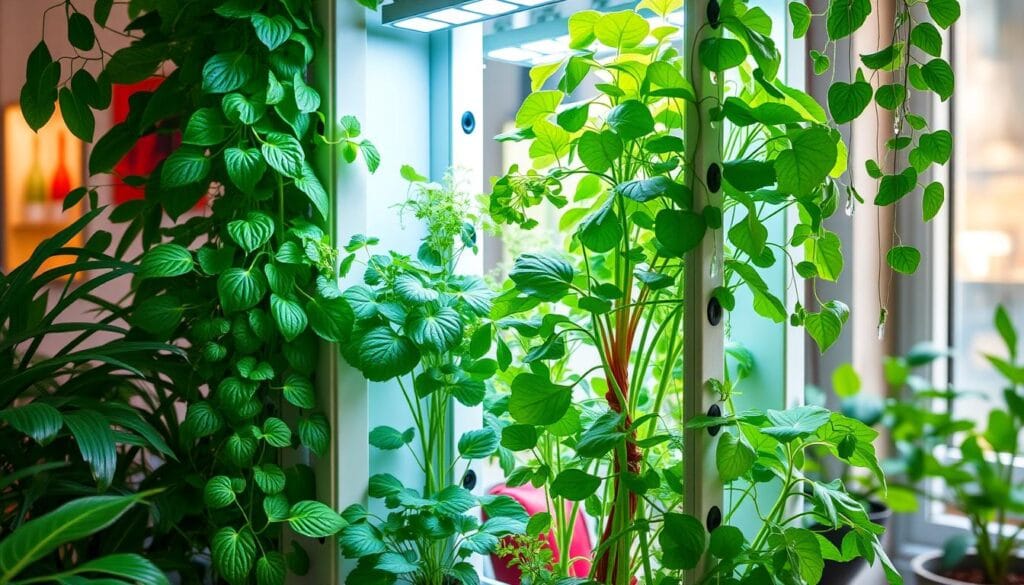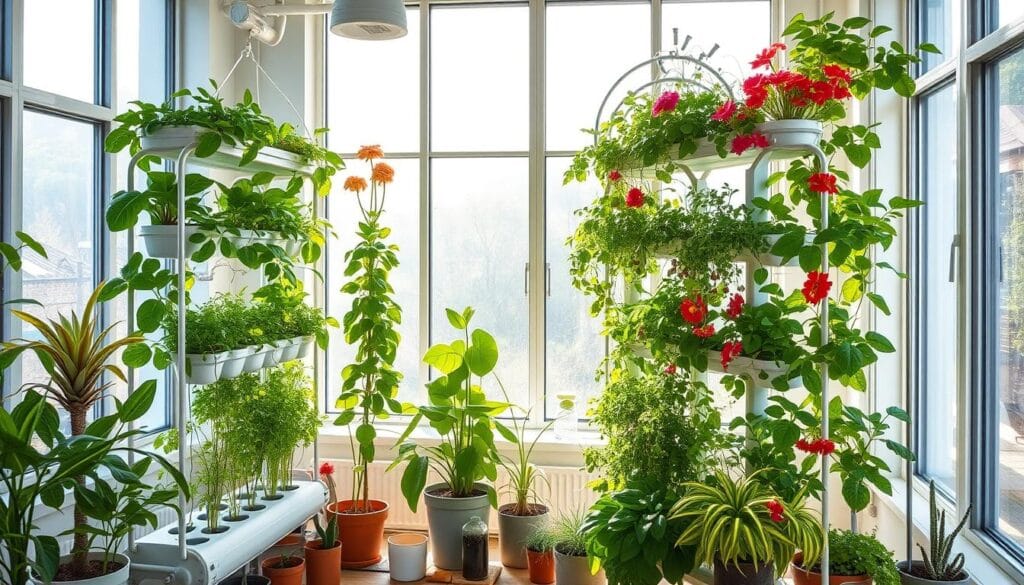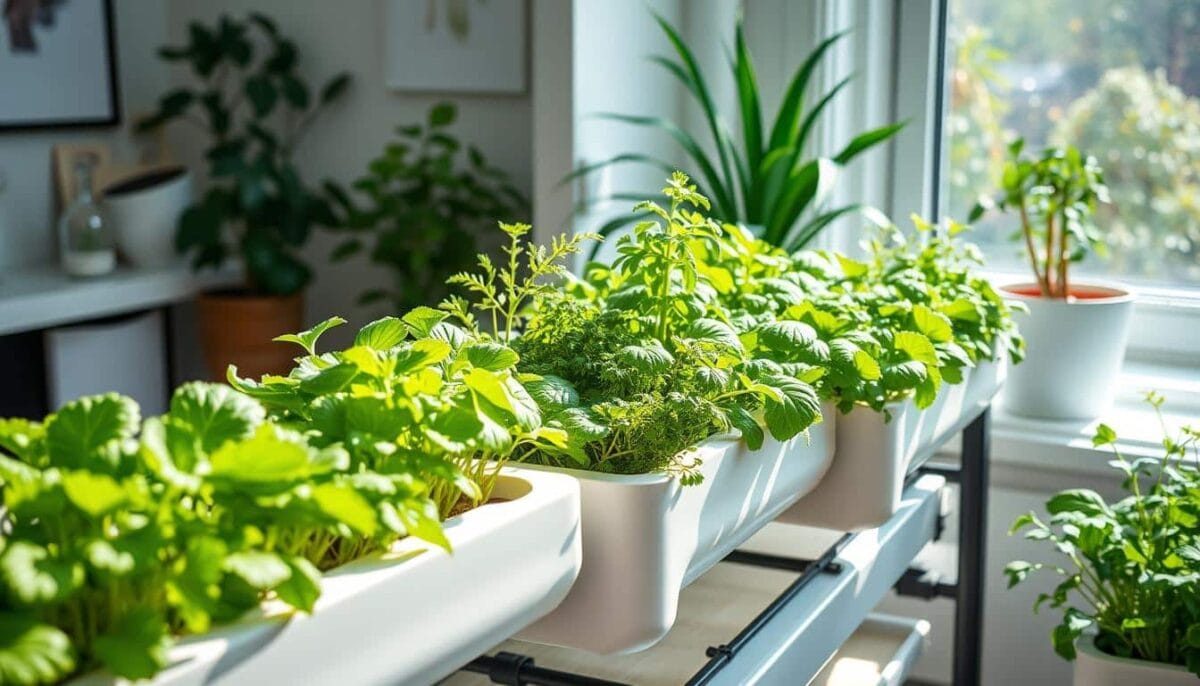Imagine growing a garden in the smallest spaces, with fresh produce just steps from your kitchen. This world is possible with hydroponic gardening. It’s a journey to self-sufficiency, sustainability, and delicious meals.
In this guide, we’ll show you the best hydroponic garden systems for your home. We’ve found the top systems for every space and budget. Say goodbye to traditional gardening and hello to indoor cultivation’s future.
Key Takeaways
- Discover the most innovative and efficient hydroponic garden systems for your home
- Learn how to grow a variety of fresh produce, including herbs, leafy greens, and more, all year round
- Explore the benefits of hydroponic gardening, such as increased yield, reduced water usage, and the ability to grow in limited spaces
- Understand the key factors to consider when choosing a hydroponic system, including size, lighting needs, and maintenance requirements
- Find the perfect hydroponic system that aligns with your budget, gardening goals, and lifestyle preferences
What is a Hydroponic Garden?
Hydroponics is a way to grow plants without soil. Instead, it uses water solutions full of nutrients. This method gives plants what they need directly through water, skipping the soil step.
Hydroponic systems use different methods to get water and nutrients to the roots. These include deep water culture, ebb and flow, drip irrigation, and aeroponics.
Definition and Basic Principles of Hydroponics
Hydroponics is a way to grow plants without soil. Plants get their nutrients from a special water solution. This solution has all the minerals and elements plants need to grow.
Because plants get nutrients directly, they grow faster and produce more. This is different from growing in soil.
Benefits of Growing Plants Hydroponically
- Year-round harvests: Hydroponic systems can grow crops all year, not just in certain seasons.
- Space-saving: You can grow plants indoors with hydroponics, perfect for small spaces.
- Water efficiency: Hydroponics uses up to 90% less water than traditional gardening.
- Controlled environment: It keeps pests, diseases, and weeds away, creating a stable growing space.
- Higher yields: Plants in hydroponics often grow bigger and healthier, leading to more food.
Hydroponic gardening has many benefits. But, it needs careful attention to the nutrient solution, pH levels, and environment. This ensures plants grow well and stay healthy.
Factors to Consider When Choosing a Hydroponic Garden System
Choosing the right hydroponic garden system for your home involves several key factors. The size and space needed, lighting requirements, and how easy it is to maintain are all important. These elements can greatly affect your indoor gardening success.
Size and Space Requirements
The space you have at home will help decide the size of your hydroponic system. Small kitchens or apartments can fit compact, countertop models. Larger systems, on the other hand, are better for bigger spaces and more plants. Hydroponics can save up to 10 times more water than traditional farming, making them space-efficient.
Lighting Needs
Good lighting is essential for a hydroponic garden. Most systems use energy-saving LED grow lights. These lights give plants the light they need to grow well. Plants usually need 12-18 hours of light a day. Make sure the lighting system you choose fits your plants’ needs.
Maintenance and Ease of Use
Consider how easy the system is to maintain and use. Look for systems with features like self-watering and smart gardening. Easy cleaning and refilling are also important. Systems that need electricity for pumps can be affected by power outages, so a steady power source is key.
By thinking about these factors, you can pick a hydroponic system that fits your needs. This will help your indoor gardening project succeed.
| Feature | Consideration |
|---|---|
| Size and Space Requirements | Compact, countertop-sized models for small spaces; larger floor-standing systems for bigger growing needs |
| Lighting Needs | LED grow lights that provide full spectrum light; 12-18 hours of light per day for optimal plant growth |
| Maintenance and Ease of Use | Automated features, smart gardening capabilities, easy cleaning and refilling; reliable power source |
AeroGarden Bounty Basic Indoor Garden
The AeroGarden Bounty Basic Indoor Garden is a favorite for growing up to 9 plants at once. It’s a compact system that makes watering and lighting automatic. This makes it perfect for growing herbs and small vegetables indoors with little effort.
This system offers the ease of hydroponic gardening without the fuss. Its 30W LED grow light gives plants the best light. The 24-inch grow height is great for taller plants. Plus, the large water bowl keeps plants well-watered and healthy.
Recent data shows that 85% of customers bought 1 AeroGarden Bounty Basic, 9% bought 2 units, and 6% bought 3 units. The Bounty Basic’s ease and ability to grow up to 9 plants at once, 5 times faster than traditional soil gardens, are big draws for hydroponic indoor gardening.
“The AeroGarden Bounty Basic is a game-changer for my small kitchen. I can grow fresh herbs and veggies year-round with minimal effort.”
Whether you’re new to gardening or have experience, the AeroGarden Bounty Basic is a great pick. Its small size and easy maintenance make it a great fit for any kitchen or living area.
Click & Grow Smart Garden
The Click & Grow Smart Garden is a compact, easy-to-use hydroponic system. It’s perfect for growing herbs and small plants indoors. It has automated watering and lighting, making it simple to care for your indoor garden.
Pros and Cons of the Click & Grow System
The Click & Grow Smart Garden has many benefits. Its small size and self-monitoring features are great for beginners or those with little space. It comes with 27 pre-seeded plant pods, so you can start growing herbs and leafy greens right away.
The Smart Garden 9 unit has a water reservoir that holds about a gallon. This means you don’t have to refill it often. The automated watering and lighting make it easy to keep your plants happy. Users have had great success, getting 4-5 harvests from leaf lettuce and enjoying herbs like basil and mint for months.
But, the Click & Grow system’s small size might limit what you can grow. Taller plants like tomatoes and sweet peas don’t do well because of the height. Some users might also want more control over their garden.
The Click & Grow Smart Garden is perfect for those wanting a simple indoor herb garden. Its automated features and variety of plant pods are great for beginners. However, experienced gardeners might find the limited space a drawback. Still, with its affordable plant pods and occasional discounts, it’s a great way to have a hydroponic garden at home.
Rise Personal Garden
Meet the Rise Personal Garden, a top-notch hydroponic system for indoor gardening. It’s small, light, and full of cool features. It’s 18 inches long and weighs only 10 lbs.
This system comes with everything you need: a base, grow lights, a water pump, and more. You get eight net cups, a garden nursery, eight seed pods, and six weeks of nutrients. It costs $279, making it a great deal for those who want fresh produce at home.
The Rise uses hydroponics, needing little water and space. It’s easy to use, perfect for those who like tech. We tested it for six weeks and found it simple to set up and use.
The Rise Personal Garden shines with its smart features. It connects to an app, letting you control lights, check plant health, and get reminders. This makes gardening easy and personalized.
Its design is both small and stylish, fitting well in kitchens. It gives you fresh produce daily or weekly. Plus, you don’t need to wash the veggies because there’s no soil or chemicals.
However, the Rise might not grow as much as bigger systems. Also, you need internet to use its smart features fully.
In summary, the Rise Personal Garden is a great pick for indoor gardening. It’s smart, easy to use, and looks good. It’s a leader in the rise hydroponic garden, smart features, app integration, and indoor gardening world.
You can buy the Rise Personal Garden on Amazon or the Rise Gardens website. It’s a simple way to enjoy fresh, homegrown food in your home.
Hydroponic Garden
Hydroponic gardens are a smart way to grow plants indoors without soil. They use water solutions full of nutrients for plants. This method helps avoid soil problems and lets you grow food all year.
One big plus of hydroponic gardening is saving space. These systems fit well in small indoor areas. They can grow more plants than soil gardens, using much less water.
Hydroponics is also good for the planet. It doesn’t need harmful chemicals or heavy metals. This makes it great for growing organic food all year, no matter the weather.
| Hydroponic Systems | Characteristics |
|---|---|
| Wick System | Suitable for microgreens, herbs, and peppers, but not recommended for water-hungry plants like lettuce and tomatoes. |
| Water Culture System | Best for growing leaf lettuce, but not suitable for long-lived plants like tomatoes. |
| Ebb and Flow System | Versatile, works by flooding the growing medium with a water-nutrient solution, which then drains back into the reservoir. |
| Nutrient Film Technique | Involves a continuous flow of water-nutrient solution through a growing tray, where plant roots absorb nutrients. |
Hydroponic gardening is a big step towards solving global food issues. It’s perfect for both new and seasoned gardeners. It lets you grow your favorite plants and enjoy fresh, healthy food at home.

AeroGarden Bounty Elite
The AeroGarden Bounty Elite is a top-notch smart hydroponic system. It brings the joy of indoor gardening right to your home. It connects to Wi-Fi and works seamlessly with an app, offering control and customization.
Smart Features and App Integration
The AeroGarden Bounty Elite has smart features that stand out. It connects to Wi-Fi, letting you control it from anywhere with the app or Amazon Alexa.
The app makes it easy to adjust lighting, get reminders, and track plant growth. You can tweak light intensity and duration for the best plant growth.
| Feature | AeroGarden Bounty Elite |
|---|---|
| Light Output | 50-watt LED |
| Planting Capacity | Up to 9 plants |
| Water Capacity | 1.1 gallons |
| App Control | Yes, with Wi-Fi connectivity |
| Voice Control | Yes, with Amazon Alexa |
| Customizable Lighting | Yes, through mobile app |
The AeroGarden Bounty Elite has a sleek design and advanced features. It’s ideal for city folks or those with little space. It lets you grow fresh produce all year.
Types of Plants Suitable for Hydroponic Gardens
Hydroponic gardens are a smart way to grow many plants. You can grow herbs, leafy greens, tomatoes, peppers, and even strawberries. The special setup and direct nutrients help plants grow well.
Choosing the right plants for your hydroponic garden is key. Think about the light, space, and nutrients each plant needs. Here are some top picks:
- Leafy Greens: Swiss chard, arugula, spinach, and more grow fast and are plentiful.
- Herbs: Basil, parsley, and mint do great in hydroponics, adding flavor to your food.
- Microgreens: Broccoli and radish microgreens are nutritious and flavorful, ready in 1-3 weeks.
- Vegetables: Celery and green onions are easy for beginners to grow.
- Edible Flowers: Carnations and marigolds add beauty and taste to your garden.
But, not all plants work well in hydroponics. Big fruit trees, potatoes, and corn don’t do well. Start with small, fast-growing plants for a great first experience.
“Hydroponic vertical farming can produce up to 2.7 million servings of leafy greens annually with just 1.5 acres of space.”
Setting Up and Maintaining Your Hydroponic Garden
Starting a hydroponic garden needs careful planning. You must choose the right system, prepare the nutrient solution, manage water, and provide the right lighting. By following these steps and solving common problems, you can grow a healthy garden. This garden will give you a lot of fresh, nutritious food.
Step-by-Step Guide to Starting a Hydroponic Garden
- Pick the best hydroponic system for your space and needs. Think about how easy it is to use, maintain, and if it’s good for the crops you want to grow.
- Get your growing medium ready and set up the system as the maker says. Make sure water flows right and nutrients get to the plants.
- Make the nutrient solution with care. Use the right amounts and check the pH to keep it healthy for your plants.
- Give your plants the right light. This could be natural sunlight or grow lights. They need enough light to grow well.
- Keep an eye on your garden often. Check the water, add nutrients, and adjust things as needed to keep your plants happy.
Common Issues and Troubleshooting Tips
Even with a great hydroponic garden, you might face problems like nutrient shortages, pH issues, or pests. Watch for these signs and fix them fast. This way, you can keep your plants healthy and your garden thriving.
- Nutrient Deficiencies: Watch how your plants grow and look. If you see signs of nutrient lack, change the solution.
- pH Imbalances: Test the pH often and adjust it if needed. This keeps the solution perfect for your plants.
- Pest Infestations: Use natural ways to fight pests, like beneficial bugs or repellents. This keeps your plants safe.
By following these tips and fixing problems quickly, you can have a healthy hydroponic garden. This garden will give you fresh, nutritious food all the time. Hydroponic gardening is a fun and green way to grow your own food at home.

DIY Hydroponic Garden Systems
Building a DIY hydroponic garden system is a fun project. Online, you can find many guides for different hydroponic setups. These range from simple ebb and flow systems to complex designs like aeroponics or aquaponics. DIY hydroponic gardening lets you customize and can save money if you’re willing to put in the work.
The Deep Water Culture (DWC) method is great for hydroponics for beginners. It’s easy to set up and maintain. You’ll need a container, water, nutrients, and light for a successful system.
For those who want to try something more advanced, there’s the hydroponic rail system. It uses 4-foot long rails from fence posts with holes for plants. This design lets you harvest continuously as new plants grow. It’s quick to build and can thrive under grow lights in a few weeks.
While DIY hydroponic garden systems can save money, they still cost around $600 to set up. Yet, the chance to customize and harvest continuously makes it appealing. It’s perfect for both beginners and experienced gardeners looking to try custom builds.
“The hydroponic rail system setup took less than 2 hours to build, and the design allows for continual harvest as new plants can replace harvested mature plants.”
Costs and Budget Considerations for Hydroponic Gardening
Setting up a hydroponic garden can cost a lot, depending on the system and size. Basic kits start at $100, while advanced systems can be over $300. You’ll also need to think about ongoing costs like electricity, nutrient solutions, and replacement parts.
But, hydroponics can save you money in the long run. You can have year-round harvests and cut down on food waste. This can help balance out the initial costs. Let’s look at the typical hydroponic garden cost, system prices, ongoing expenses, and long-term savings in more detail.
Types of Hydroponic Systems and Their Costs
There are many types of hydroponic systems, each with its own price tag:
- Deep Water Culture (DWC): Costs start at $50 for basic and $200 for advanced.
- Nutrient Film Technique (NFT): Starts at $75 for basic and $250 for advanced.
- Drip Irrigation System: Begins at $50 for basic and $200 for advanced.
- Ebb and Flow System: Starts at $75 for basic and $250 for advanced.
- Aeroponics: Begins at $100 for basic and $300 for advanced.
- Wick System: Starts at $25 for basic and $100 for advanced.
Remember, prices can change based on equipment quality, system size, and features.
| Hydroponic System Type | Basic System Cost | Advanced System Cost |
|---|---|---|
| Deep Water Culture (DWC) | $50 | $200 |
| Nutrient Film Technique (NFT) | $75 | $250 |
| Drip Irrigation System | $50 | $200 |
| Ebb and Flow System | $75 | $250 |
| Aeroponics | $100 | $300 |
| Wick System | $25 | $100 |
Knowing the costs of different hydroponic systems helps you choose wisely. It ensures your budget and gardening goals align.
Conclusion
Hydroponic gardening is a smart way to grow food indoors all year. It uses water instead of soil, making it perfect for any space. You can find systems for small kitchens or bigger setups, fitting all budgets.
With the right care, hydroponic gardening gives you fresh food for your kitchen. It also saves water and is good for the planet.
Looking to grow a little or a lot indoors? Hydroponic gardening is a great choice. It’s a green way to get fresh, local food all year. Your home can become a lush garden, helping the planet and you.
In short, hydroponic gardening is a smart pick for growing food at home. There are many systems to choose from, fitting every need and budget. It lets you grow a vibrant indoor garden, bringing many benefits to your life.

